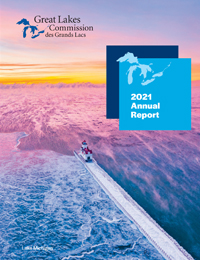UW-Oshkosh adds pollution-fighting vessel to help clean Wisconsin waters
From Memorial Day to Labor Day, the boat will focus on cleaning up Lake Michigan, Green Bay, and the Fox River. They’ll specifically target areas around marinas, where they expect to find concentrations of litter. Read the full story by Spectrum News 1.
Great Lakes Commission
https://www.glc.org/dailynews/20220520-pollutionvessel-greatlakes












 The 2021 Great Lakes Commission Annual Report includes remarks from Chair Todd L. Ambs and Executive Director Erika Jensen. The Commission’s annual reports traditionally include remarks from our chair and executive director as well as information regarding revenues, expenses, and commissioners.
The 2021 Great Lakes Commission Annual Report includes remarks from Chair Todd L. Ambs and Executive Director Erika Jensen. The Commission’s annual reports traditionally include remarks from our chair and executive director as well as information regarding revenues, expenses, and commissioners.


